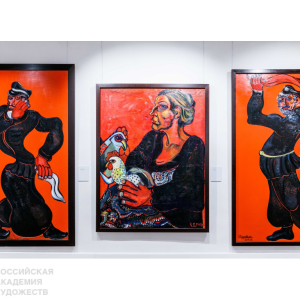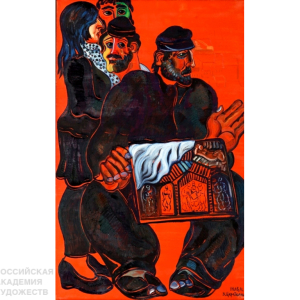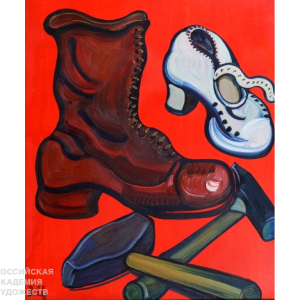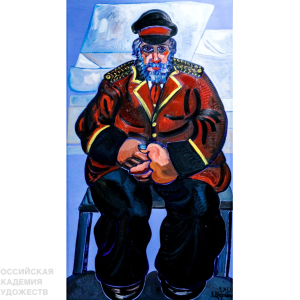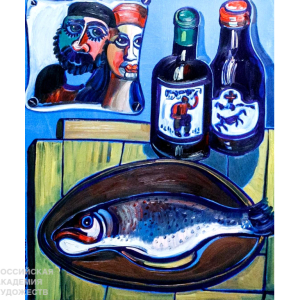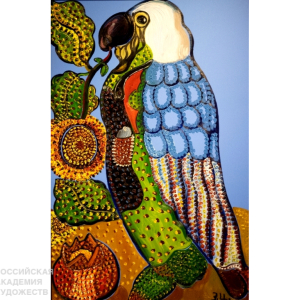MORE THAN LIFE: EXHIBITION OF WORKS BY ZURAB TSERETELI IN BEIJING
Dates: 03.09.2023 – 26.09.2023
Venue: The National Art Museum of China (NAMOS) (Beijing, Dunchan, 1 Usydatsze; Halls 2.4.10)
THE OPENING OF THE EXHIBITION: SEPTEMBER 4, 2023 AT 16.00
The National Art Museum of China, the Russian Academy of Arts and the Moscow Museum of Modern Art present the exhibition project of the UNESCO Goodwill Ambassador, People’s Artist of the USSR and Russia, President of the Russian Academy of Arts Zurab K. Tsereteli timed to his 90th anniversary. The More than Life exhibition features the artist’s canvases and enamels including “I Was Born a Gardener”, “Bebiko”, “Circus”, “Charley Chaplin”, “The Masters”, “Old Tiflis”, as well as sculptures fr om the “Townspeople” series. The Project is being implemented as part of the Agreement between the Russian Academy of Arts and the National Art Museum of China headed by Mr. Wu Weishan – the Honorary Member of the Russian Academy of Arts since 2011.
Tsereteli's space is a kind of accumulator of emotions, here the voids are filled with juicy strokes that form a monumental mosaic. Each of the polyhedrons of this mosaic is complex worlds, the boundaries of which are crossed by the artist who captivates the viewer with him. To build images, playing with elements of different styles and directions, to find and expressively reveal the universal scale in small forms of everyday life, to plunge into the labyrinths of mythology, and upon returning, to project fantasies onto the dense fabric of the canvas, to compose the "possible" worlds that each person represents - all these and many other features of the artistic method can be attributed to the characteristics of the art of Zurab Tsereteli.
The combination of the incompatible, fantasy, dream, reality as reality, absolute reality - this is a stable structure that remains a constant for Tsereteli's art. The mysterious codes of the culture of the Caucasus, sounding either as an absolute reality, or as a legend, for example, in the poem "The Knight in the Tiger Skin", invariably serve as an inexhaustible source of inspiration, knowledge of life, become a theme for the work of many artists to this day. So the sad organ-grinder, violinist, bathhouse attendant are a motley crowd that makes up a series of characters from Tbilisi that is disappearing. Full of folklore enthusiasm, the scene of everyday life is replaced by the next canvas with a completely different story, which is hidden behind the semantic and visual layering of the image.
Tsereteli's art is distinguished by a pictorial and energetic environment characteristic of the so-called "magical realism", in this case, its artistic version. In the works of Zurab Tsereteli there is often an unexpected combination and sometimes the interconversion of different objects, human figures, animals, fish, birds and architectural structures, that forms a vivid plastic image of the canvas as a whole. We see, we feel, that each canvas or sheet of paper has many dimensions and spatial breakthroughs which both transcend the boundaries of the sheet and at the same time remain in harmony with these boundaries. The imaginary chaos, the layering of different plans, the hypertrophied interpretation of the form, nevertheless, gives the general impression of the harmony of life, with its sharp "angles", "burrs", "bumps", all the texture that makes it up.
The artist’s paintings are metaphorical, invariably speaking the language of a parable, as if part of a large-scale picture of the world. The plots seem to be extremely simple, they tell about life in its most ordinary manifestation, but they are depicted with some epic power significance. The invariably large sad eyes of people, dogs, horses, birds resemble a painted space of life with deep chords of experiences. It is difficult to determine the style or one concrete direction for the artist's works. Everyone will always see something different. In their compositional structure, paintings are similar to animated dreams - sometimes black and white, sometimes color. It is difficult to say which technique the master prefers more, it seems that it depends on the mood and on the presence at hand of this or that material that can visualize the images that have arisen in the head. At the same time, as the main goal of creativity, as a super-task is the presence of a certain positive gene that is unshakable in his works, it is impossible not to succumb to the charm of his cordial, open characters.
It is important to note the general aspiration to the images of the primordial nature, the proto-man, to the beauty devoid of pathos, brilliance, gloss, to the beginning which should symbolize the truth. The history of the world is as significant for the universe as the story of the little man, his aspirations. Often, it is in contrast with a feeling of a certain dissonance, that the main theme is unexpectedly revealed, it is the very essence of something very global, the very "beginning of everything" for the sake of which, perhaps, a human was created.
Tsereteli creates his own reality. The composition, as a rule, is complex, multifaceted, in which the narrative has almost completely disappeared and turned into a sculptural event. The master often covers the entire space of the sheet without leaving almost any free space. The composition is always characterized by a certain sophisticated complexity, which at the same time is sensed as very organic. His canvases usually have many points of view, they are saturated with movement, united "in the simultaneity of moments of different times," as the famous Russian artist and theorist, academician Vladimir Favorsky characterized this approach.
The centuries-old folk culture, national variations of the traditions of buffoons, humor culture, return to the original, genuine through grotesque, laughter for the sake of revealing the secret, closed, unknown, but real world - all this can be found in almost every painting or drawing by Zurab Tsereteli. The romantic fantasy merges with everyday life and sometimes triumphs over it, professing an unshakable faith in goodness - these are the super tasks of magical realism, and they organically coincide with the artistic concept of Tsereteli's art.
Transforming the tradition basing on the national roots, Tsereteli strives for a synthesis of reality and myth, its close interweaving into artistic "fabrics". The world of fantasy is a world of emotions with a lot of shades a holistic, a lively and multifaceted image. The emotional implication of the image can be interpreted both as a concrete thing and a symbol, as a supersensible, metaphysical phenomenon. The master enthusiastically comprehends the plastic nature and metaphysical essence of the depicted objects. He builds a complex system of hints and associations, uses the direct and allegorical meaning of things in order to give a general "narration" about human existence, about different fates, about the beauty of life. Many characters and objects in the drawings act as if on the principle of a kaleidoscope - each movement of the hand produces intricate compositional variations on the sheet.
Among the most common images are cards, candles as a symbol of hope, human life and, sadly, death too; fish – "birds of the earth", the symbols of Jesus Christ; many signs make up the visual culture of many millennia. In drawings, as well as in paintings, it is the fish that more often than all other creatures and objects fills as if by chance the voids on the sheet: then a basket with fish appears, then a rope on which the fish is dried, then fish on the table and even under the table in the paws of a mischievous cat, that results in the sense of a chain of events.
A series of images passes before the attentive eye, which makes it possible for each of the drawings to break out of the framework of the usual genre sketch. Whatever the plot, in most of the drawings you will definitely find the tops of churches and chapels, a lonely cross in the mountains or among the chaotic heap of houses of a noisy city. In the city or on the road you will definitely meet a fishmonger, and closer to the sea - a fisherman. Having been placed in a drawing with intent or unconsciously, such "signs" bring the whole variety of plots, characters, types and angles into a single whole, refer to a certain all-encompassing biblical scale. If we speak about themes in the artist's art, these are "Man and Woman", "Man and Nature", "God and Man", "Man and His Character". These global topics uniting both the Biblical history and folk wisdom of fairy tales cover the creative work of Tsereteli and continue the amazing line that ultimately unites the art of almost all eras known to the world. There is an invisible line of the heart that connects worlds and continents, revealing the perception of the world as a great creative workshop, wh ere any topic, any hero cannot be minor and of small interest just because he lives in this world.
There is a stable hypothesis that in the creative life of every great artist there is a special motive that he seeks to reveal in each of his artworks. To express himself Zurab Tsereteli has walked along different roads, his life lines have tightly intertwined into a single knot named as art. What theme can be called the main one and can it embrace the entire space of his life and work? Someone will say - the theme of Love, Faith, Good and will be right. However, looking at the works of the master, you are convinced that his main theme is life itself in its momentary sketches and monumental canvases of eternity, in its intimacy and sometimes destructively grandiose scale. And every day, saturating the palette with a portion of fresh colors or filling the pen with ink, the artist begins to rediscover a new chapter of the novel called life.
print version

